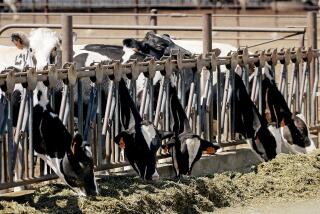Dairies Yield to Changes in Economics, Production
- Share via
BEAVERDAM, Va. — Walt Wickham Smith milks his last remaining black-and-white cow, pulls a pocketknife from his faded denim overalls and gently prods her past rows of empty stalls into an oddly silent barnyard.
So quiet. You can hear cats lapping fresh milk from a big metal bowl and a dog barking clear across the cornfield. Loose metal on an empty grain silo squeals whenever the breeze picks up.
The glass facing of the employee punch clock is cracked, the time frozen at 7:40, and the 20 card slots are empty.
“Dead, isn’t it?” Smith asks, not expecting an answer.
From the time he was a kid milking his grandfather’s herd until a month ago, Ingleside Farm in northwestern Hanover County was filled with the sounds of milk machines and hundreds of Holsteins mooing and clopping about the barn.
At an auction in September, the 300 cows were sold, one by one. All except for Candy, who was kept as a pet and a memento.
Smith may be lonely, but he’s not alone. Twenty-five years ago, there were about 20,000 farms with milk cows in Virginia. Now there are less than 2,200.
*
Nationally, there were 647,000 farms with milk cows in 1970, according to the Agriculture Statistics Service. There were only 140,000 in 1995.
The loss has been fairly steady. But this fall, after a decade of low milk prices and months of record-high grain costs, the failure rate for dairy farms has increased.
“There have been more people pushed to the brink because of the economics and more farm sales,” said Jim Lawson of the Virginia Agricultural Statistics Service. “It’s put too much on the dairy folks and it’s forcing them to give up.”
The number of milk cows declined 66% in Virginia and dropped 76% nationally from 1970 through 1995. But milk production actually increased in those 25 years because breeding improvements have developed cows that produce much more milk.
The price consumers pay for milk has risen little in the past decade; the combined gross income of Virginia milk producers has dropped from $298 million in 1990 to $269 million in 1995.
“In Virginia, farmers compete with residential, commercial and recreational land, and the income per unit has gone down tremendously,” said Virginia Milk Commission Administrator Rodney Phillips. “Farmers have to generate more and more milk in order to keep up. But they are limited by land, capital to expand and age.”
Few can afford to get into dairy farming. William Vinson, head of Virginia Tech’s dairy science department, estimated it would take $1 million for someone to start a dairy farm with a 100-cow herd.
The lack of people willing to work as dairy hands and the reluctance of children to take over the family dairy farm has hastened the decline, dairy farmers said. Cows must be milked twice a day, seven days a week--and that requires labor.
“It’s a tough job,” said Don Quesenberry of Washington County, who also sold his herd in September. His two daughters didn’t marry farmers and moved away. “The only way I survived the last 10 years was intense supervision. I’m 64, and I was extremely tired.”
Ken Wooden, a dairy extension agent in Franklin County, said costs increase as the number of farms and the number of farm service providers dwindle in an area. Veterinarians have to travel farther to farms, and farmers have to travel farther to feed and seed stores.
Virginia Tech agriculture economist Wayne Purcell said small dairy farms “are going to have a very difficult time surviving.”
The fate of a marginally productive cow is even worse.
“She gets one strike and she’s probably out,” said Craig County extension service agent Roy Kiser. “Farmers are heavily culling and sending cows to the market for slaughter.”
Quesenberry also kept one his 200 dairy cows as a pet, an unusual Brahman-Holstein mix named Ramona.
“I really miss those black-and-white cows, and I guess I always will,” Quesenberry said.
He got into the habit of waking up at 3 a.m. and looking out of his bedroom window to make sure the lights were on in the barn, a sign that workers had started the milking.
“Now I still wake up, and I realize that I’m not going to see any lights,” Quesenberry said.
But the horizons still glow at night as the suburbs of Bristol creep closer to the farm.
“We’re surrounded by subdivisions,” Quesenberry said. “This time next year, I’ll be looking at streets and houses.”
More to Read
Sign up for Essential California
The most important California stories and recommendations in your inbox every morning.
You may occasionally receive promotional content from the Los Angeles Times.












